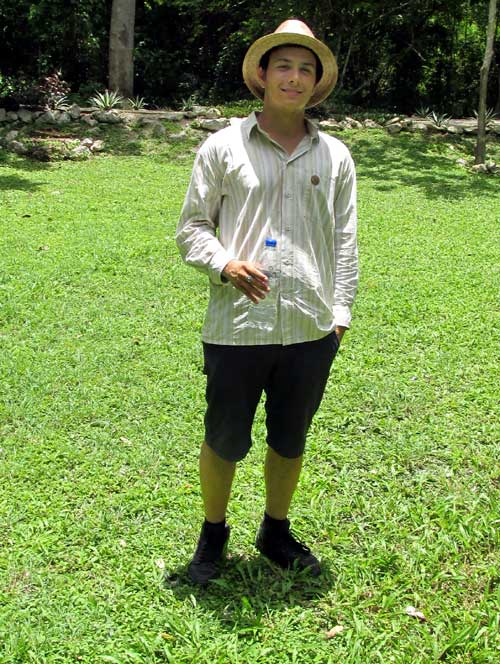Excerpts from Jim Conrad's
Naturalist Newsletter
from the July 24, 2016 Newsletter issued from Hacienda Chichen Resort beside Chichén Itzá Ruins, central Yucatán MÉXICO
RALFS AT MIDDAY
The other day around noon I took a picture of my Latvian friend Ralfs because he was doing something utterly impossible to accomplish in North America and Europe. See if you can figure out his feat in the picture below:

What Ralfs is doing is casting a shadow that hardly extends from right beneath him. North Americans and Europeans can't do that because those continents are north of the Tropic of Cancer, so the Sun never shines directly overhead there, and thus can never cast a shadow directly beneath anything it shines on. Here we're south of the Tropic of Cancer, so for a time each year the midday Sun is north of us, while the rest of the year it's to the south. Twice a year, when its daily path, or ecliptic, either approaches the Tropic of Cancer or starts leaving it, it passes directly overhead here. Around this time of year, at midday, at a certain moment, it's nearly exactly overhead.
On the Internet you can learn how near shining directly overhead the Sun can get in your area. The US Navy provides a page for helping you at http://aa.usno.navy.mil/data/docs/AltAz.php
There you need to plug in either the name of your US city or else provide coordinates of latitude and longitude for your location elsewhere on Earth. Down the page, there's a link where you can find your own latitude and longitude.
Plugging in Chichén Itzá's coordinates of W 88° 44', N20° 42' I find that for the date July 22, 2016 the Sun during its journey from east to west is closest to exactly overhead between 12:00 and 12:10 CST -- 89.8° at 12:00 and 90.7° ten minutes later. When it's at 90° it's at the highest point of journey from horizon to horizon -- its azimuth -- but it was not necessarily directly overhead. On July 22, the point at which it was closest to directly overhead, independent of whether it was at the highest point of its azimuth, was at 1PM, when it stood at 89.3° from the horizon. That number is referred to as its altitude, and 90° would be exactly overhead. The two points don't coincide in time because the Earth is tilted on its axis as it orbits the Sun.
Our 89.3° means that on July 22 the Sun wasn't exactly overhead, but pretty close. During the Summer Solstice, here at midday the Sun would be lower than it is now, a bit to our North, because we're south of the Tropic of Cancer, which is where, on the Solstice, the Sun would be directly overhead. Here the Sun is most overhead twice a year, as its journey takes it to and from the Northern Hemisphere's Tropic of Cancer.
If you do these figures for your location anyplace else than between the Tropics of Capricorn and Cancer, you'll find that your numbers simply never approach 90°, and in Ralfs' Latvia so close to the Arctic, the numbers are far from 90°, and people's shadows always are much, much longer.